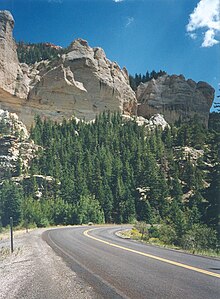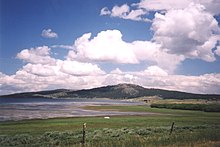Is Sr 143 in Ut Open Again?
| | ||||
|---|---|---|---|---|
| Brian Head-Panguitch Lake Scenic Byway Utah's Patchwork Parkway | ||||
 | ||||
| Route data | ||||
| Maintained past UDOT | ||||
| Length | 51.206 mi[one] (82.408 km) | |||
| Existed | 1933[ii]–present | |||
| Tourist routes | | |||
| Major junctions | ||||
| Due west end | | |||
| East terminate | | |||
| Highway system | ||||
| ||||
| ||||
State Road 143 (SR-143) is a state highway in the U.Due south. state of Utah. The entire highway has been designated the Brian Head-Panguitch Lake Breathtaking Byway as part of the Utah Scenic Byways plan. This route has as well been designated as Utah'south Patchwork Parkway as part of the National Forest Scenic Byway programme.
At just over 51 miles (82 km) long, it connects Parowan to Panguitch while providing access to Brian Caput, Cedar Breaks National Monument, and Panguitch Lake. It is also the 2nd-highest paved road in the state at 10,626 anxiety (3,239 k) above sea level.
The western department of the road from Parowan started as a logging road for nineteenth century Mormon pioneers and was designated a throughway in 1933. Xx years afterward, the route was extended to Cedar Breaks National Monument, and once again in 1985 to its nowadays-twenty-four hours eastern terminate in Panguitch.
Route description [edit]

White cliffs and wood on the way up Parowan Canyon
Land Route 143 begins at Interstate 15 in Iron County just west of Parowan as 200 South and travels through the center of town earlier turning southward into Parowan Canyon.[3] From hither, the route climbs past the Vermillion Cliffs,[4] named for their reddish color produced by iron oxides.[5] Farther up the canyon, the highway passes by the White Cliffs as information technology enters Dixie National Woods, and begins a steep climb upwardly to Brian Head. The grade reaches 13% in some places, sharp enough that travel by RVs or semi trucks is not recommended.[4]
As the route climbs onto the Markagunt Plateau at an tiptop of well-nigh ten,000 feet (3,000 m), it enters the town of Brian Caput, Utah's highest incorporated urban center and the home of Utah'due south highest ski resort, Brian Head Ski Resort.[6] From the acme of this plateau, vistas open up allowing for views of over 100 miles (160 km) in every direction.[seven] The area is populated with Engelmann spruces, aspens, and alpine meadows total of wildflowers. SR-143 continues climbing southward, passing the northern edge of Cedar Breaks National Monument, a natural amphitheater canyon eroded out of the western border of the plateau similarly to Bryce Coulee.[5] Here, the road reaches its highest point at 10,626 feet (three,239 m) above sea level, the second-highest paved road in Utah behind the Mirror Lake Highway at 10,715 feet (3,266 m).[8] The route turns to the east hither, while continuing south leads to the rest of Cedar Breaks National Monument and State Route 148 (the Cedar Breaks Scenic Byway).[ane]

Equally the highway heads eastward, it descends through thick aspen forests interspersed with ancient lava fields.[4] Distant views to the Escalante Mountains, Sevier Plateau, and the Pink Cliffs of Paunsaugunt Plateau are visible to the southward and east.[4] [7] On this leg of the route, it passes around the south and east sides of Panguitch Lake, which is popular for summertime line-fishing likewise as winter ice fishing.[vi] SR-143 continues its descent, heading northeast alongside Panguitch Creek[3] [iv] every bit information technology enters Garfield County and exits Dixie National Forest.[1] The route ends at U.S. Route 89 in the city of Panguitch,[1] 25 miles (40 km) from Bryce Canyon National Park[ix] and only e of the Paunsaugunt Plateau.[10] [11]
History [edit]
Early on roads [edit]

Primitive hunter-gatherers used this road equally far back equally the Fremont civilisation (AD 700 – 1300). Evidence of their passage is constitute along the roadway in the course of rock art.[12] More recently, around the time of European settlement, the area was inhabited past the Southern Paiute people[12] who used much of the Markagunt Plateau for hunting and gathering.[thirteen]
The boondocks of Parowan was settled in 1851 by Mormon pioneers, who built a wagon road up Parowan Coulee to access timber for buildings.[13] [14] Eventually, this road extended south to Cedar Breaks. In 1919, Southward. A. Halterman took the first automobile to Cedar Breaks via Parowan Canyon. With improvements to the road completed past 1921, he was able to take visitors on weekly trips to the area.[14]
Parowan to Cedar Breaks [edit]
Land Route 143 was first commissioned in 1933 as the road from Parowan to the Dixie National Forest boundary.[ii] The route was extended in 1953 to reach from U.S. Route 91 (former State Road one) in Parowan (Main Street) to the north purlieus of Cedar Breaks National Monument,[2] increasing its length to over 17 miles (27 km).[iii]
The construction of Interstate 15 (I-15) in the Parowan area caused the state legislature to twice change the alignment of SR-143. The kickoff change came in 1968, due to I-15 existence constructed to bypass Parowan w of boondocks, rather than post-obit the route of The states-91/SR-1 through the center of town. As a result, the state legislature moved SR-1 west onto the interstate alignment while keeping the erstwhile alignment in the state highway system. This was achieved past designating the one-time southwestern office of SR-ane from I-xv at Summit to Center street in Parowan as a new highway (SR-38) and extending SR-143 through north Parowan up to I-15, incorporating the northwestern part of the onetime SR-ane alignment.[two]
In 1975, the structure of I-xv was complete, including a 2nd Parowan interchange that had non been in the original plans. This interchange was located west of Parowan, betwixt the Pinnacle interchange to the southwest, and the Parowan interchange to the due north. In response, the legislature rerouted SR-143 to connect to the w interchange. Instead of turning due north on Main Street, SR-143 now turned south on Main Street for two blocks (coinciding with SR-38) and turned west to reach the new interchange. The two blocks of Main Street overlapping SR-38 were transferred to SR-143, with the residue of that route deleted and withdrawn from the state highway system. The one-time route of SR-143 northerly through Parowan was re-designated SR-274.[two]
Cedar Breaks to Panguitch [edit]

The other end of SR-143 has undergone route changes too. Prior to 1969, SR-55 connected SR-14 with the southern purlieus of Cedar Breaks National Monument. That year, as part of a major realignment of state highways, SR-55 was deleted and its route was designated as part of SR-143. This left SR-143 as a not-contiguous highway, as the portion going through the national monument was not office of the highway designation.[ii]
In 1985, the southern portion of SR-143 betwixt SR-14 and the southern Cedar Breaks National Monument purlieus was re-designated SR-148, and Panguitch Lake Road from the eastern monument boundary to Usa-89 in Panguitch was added to SR-143. In this same legislative resolution, there was a provision that the portion of the route alignments inside the boundaries of the national monument would be included as part of the state highway organisation once the Utah Section of Transportation was granted a correct-of-mode easement from federal authorities.[2] In 1994, the legislative description of SR-143 was updated to reflect that this easement had been granted. SR-148 still ends at the south boundary of the national monument.[xv] [sixteen]
The route was designated as a Utah Scenic Byway called Brian Head-Panguitch Lake Breathtaking Byway in 1989, and as a Forest Service Byway called Utah'due south Patchwork Parkway in 2000.[17] It is also currently being considered for nomination as a federal All-American Route.[18]
Major intersections [edit]
References [edit]
- ^ a b c d e "State Road 143 Highway reference" (PDF). Utah Section of Transportation. December 2008. Retrieved July fifteen, 2009.
- ^ a b c d due east f m "Land Route 143 Resolutions" (PDF). Utah Department of Transportation. November 2008. Retrieved July xv, 2009.
- ^ a b c Google (July xx, 2009). "Utah Country Road 143" (Map). Google Maps. Google. Retrieved July 20, 2009.
- ^ a b c d e "Scenic Byways and Backways". Cedar City/Brian Head Tourism Bureau. Retrieved July 20, 2009.
- ^ a b "Pioneer History and Scenery on Utah'south Patchwork Parkway". Federal Highway Administration. Retrieved July 20, 2009.
- ^ a b "Brian Head-Panguitch Lake Breathtaking Byway". Utah Travel Industry. Retrieved July 20, 2009.
- ^ a b "Utah's Patchwork Parkway Scenic Byway Corridor Management Plan, Chapter 10 - Scenic" (PDF). Breathtaking Byway 143 National Designation Steering Committee. Retrieved July twenty, 2009.
- ^ Arave, Lynn (March 22, 2007). "Enjoy Utah's scenic heights from your motorcar". Deseret News. Salt Lake City, Utah. Retrieved July 15, 2009.
UDOT agrees that state Route 143, the segment by Cedar Breaks National Monument, is the state's 2nd-highest paved road. It reaches 10,626 feet above ocean level.
- ^ "Panguitch Visitor Data". City of Panguitch, Utah. Retrieved Baronial 7, 2009.
- ^ Benke, Arthur C.; Cushing, Colbert Eastward. (2005). Rivers of North America. Academic Press. p. 668. ISBN978-0-12-088253-three.
- ^ Kiver, Eugene P.; Harris, David V. (1999). Geology of U.S. Parklands. John Wiley and Sons. p. 524. ISBN978-0-471-33218-3.
- ^ a b "Utah's Patchwork Parkway Scenic Byway Corridor Management Program, Chapter 5 - Archeological" (PDF). Scenic Byway 143 National Designation Steering Committee. Retrieved July 26, 2009.
- ^ a b "Utah's Patchwork Parkway Scenic Byway Corridor Management Plan, Chapter 7 - Historical" (PDF). Scenic Byway 143 National Designation Steering Committee. Retrieved July 26, 2009.
- ^ a b Hinton, Wayne 1000.; Powell, Allen Kent (1994). "Cedar Breaks National Monument". Utah History Encyclopedia. University of Utah: University Press. Retrieved July 26, 2009.
- ^ "State Route 148 Highway reference" (PDF). Utah Department of Transportation. May 2008. Retrieved July 15, 2009.
- ^ "Country Route 148 Resolutions" (PDF). Utah Department of Transportation. November 2008. Retrieved July fifteen, 2009.
- ^ "Utah'southward Patchwork Parkway (U-143) - Official Designations". Federal Highway Assistants. Retrieved July 15, 2009.
- ^ "Scenic Byway 143". Iron County. Retrieved July fifteen, 2009.
External links [edit]
Road map:
KML is from Wikidata
-
 Media related to Utah Land Route 143 at Wikimedia Commons
Media related to Utah Land Route 143 at Wikimedia Commons
Source: https://en.wikipedia.org/wiki/Utah_State_Route_143

0 Response to "Is Sr 143 in Ut Open Again?"
Post a Comment